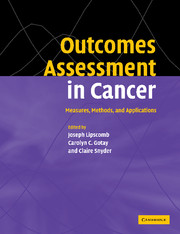Book contents
- Frontmatter
- Contents
- List of contributors
- Acknowledgments
- 1 Introduction to Outcomes Assessment in Cancer
- Health-related quality of life in cancer: general concepts and generic measures
- Assessing health-related quality of life during treatment
- 5 Quality of life in breast cancer: what have we learned and where do we go from here?
- 6 Measuring quality of life in prostate cancer: progress and challenges
- 7 The science of quality-of-life measurement in lung cancer
- 8 Treatment for colorectal cancer: impact on health-related quality of life
- 9 Instruments to measure the specific health impact of surgery, radiation, and chemotherapy on cancer patients
- Assessing health-related quality of life across the cancer continuum
- Measuring the experience and needs of cancer patients and caregivers
- Methodological considerations in applications to cancer outcomes research
- Modern psychometric theory in cancer outcomes research
- Assessing the economic impact of cancer
- Research and policy implications
- Invited papers
- Index
- References
5 - Quality of life in breast cancer: what have we learned and where do we go from here?
Published online by Cambridge University Press: 18 December 2009
- Frontmatter
- Contents
- List of contributors
- Acknowledgments
- 1 Introduction to Outcomes Assessment in Cancer
- Health-related quality of life in cancer: general concepts and generic measures
- Assessing health-related quality of life during treatment
- 5 Quality of life in breast cancer: what have we learned and where do we go from here?
- 6 Measuring quality of life in prostate cancer: progress and challenges
- 7 The science of quality-of-life measurement in lung cancer
- 8 Treatment for colorectal cancer: impact on health-related quality of life
- 9 Instruments to measure the specific health impact of surgery, radiation, and chemotherapy on cancer patients
- Assessing health-related quality of life across the cancer continuum
- Measuring the experience and needs of cancer patients and caregivers
- Methodological considerations in applications to cancer outcomes research
- Modern psychometric theory in cancer outcomes research
- Assessing the economic impact of cancer
- Research and policy implications
- Invited papers
- Index
- References
Summary
Introduction
Breast cancer is the most common cancer in North American women, accounting for about a third of all incident cancers. In 2004 in the USA, there are projected to be 215 900 newly diagnosed cases of female breast cancer and 40 110 deaths. During the past 5 years, the mortality rate for breast cancer has declined significantly, most likely due to a combination of wider use of mammographic screening and the diffusion of adjuvant therapy for stage I and II disease. In spite of this improvement in mortality, the number of incident cases of breast cancer is projected to rise with the continued aging of the population, as breast cancer peaks in women in the 8th decade of life.– Unless major advances in the prevention of breast cancer occur, using chemoprevention and other risk reduction strategies, the absolute number of breast cancer patients and survivors will continue to increase as we move further into the 21st century.
The majority of women with breast cancer are diagnosed with early-stage localized disease. In fact, tumor size at diagnosis has continued to decrease, with very small invasive and non-invasive cancers being detected through mammographic screening. Some series estimate that about 20% of incident cases are now non-invasive (stage 0) ductal carcinoma in situ. However, in spite of these decreases in tumor size and invasiveness, almost all patients diagnosed with breast cancer receive localized breast surgery (breast-conserving surgery and radiation to the breast or a modified radical mastectomy, with or without reconstruction).
- Type
- Chapter
- Information
- Outcomes Assessment in CancerMeasures, Methods and Applications, pp. 93 - 125Publisher: Cambridge University PressPrint publication year: 2004
References
- 3
- Cited by



